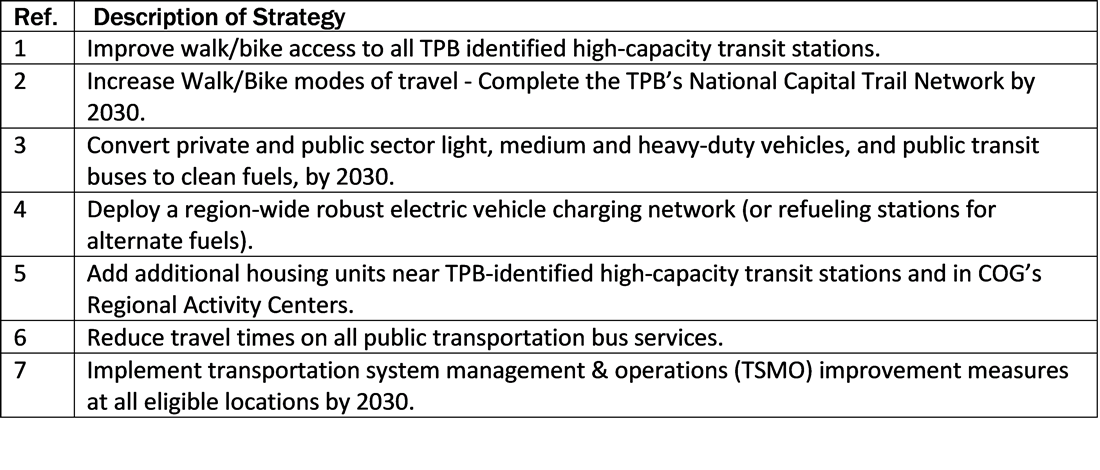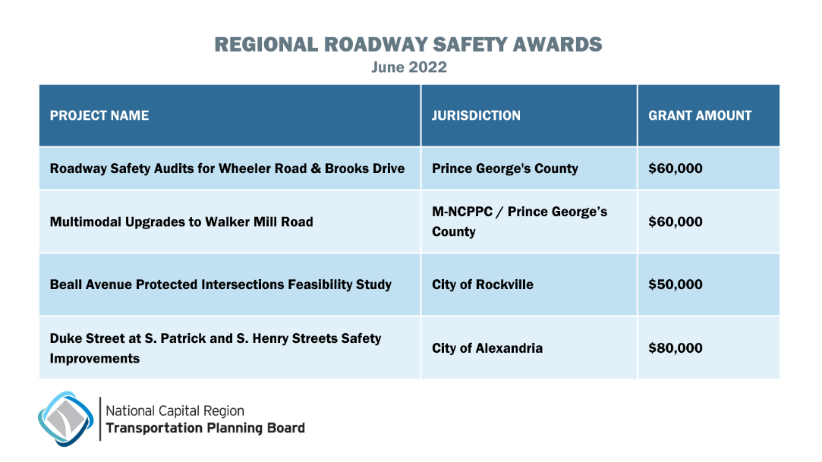TPB Approves Visualize 2045 Long-Range Transportation Plan Update and Transportation-Sector Greenhouse Gas Reduction Goals and Strategies
On June 15, the TPB approved the Visualize 2045 Long-Range Transportation Plan Update and found that the FY 2023-2026 Transportation Improvement Program (TIP) and the Plan Update conform to the requirements of the Clean Air Act Amendments of 1990. In addition, the TPB, as metropolitan planning organization (MPO) for the National Capital Region, certified that the metropolitan planning process is being carried out in accordance with applicable Federal Highway Administration (FHWA) and Federal Transit Administration (FTA) requirements.
Later at the meeting, the TPB adopted groundbreaking on-road transportation sector greenhouse gas (GHG) reduction goals of 50 percent below 2005 levels by 2030 and 80 percent below 2005 levels by 2050. Part of the approval was adoption of seven GHG reduction strategies and identification of seven other greenhouse gas reduction strategies that have the potential to reduce on-road GHG emissions that merit further discussion by the TPB member jurisdictions. According to staff research, the TPB, by taking this action, is the first MPO in the country to voluntarily adopt GHG goals for the on-road transportation sector.
Meeting Agenda, materials, and recording.
Visualize 2045 Long-Range Transportation Plan Update
Stacy Cook, TPB Transportation Planner, introduced the three Visualize 2045, TIP, and Self-Certification resolutions for board adoption:
- Resolution R15-2022: Affirming that the Visualize 2045 Update meets federal transportation planning and fiscal constraint requirements.
- Resolution R16-2022: Affirming that the Visualize 2045 Update meets federal Air Quality Conformity requirements for mobile source Volatile Organic Compounds (VOCs) and Nitrogen Oxides (NOx) emissions associated with the plan and TIP are below the Environmental Protection Agency’s (EPA) approved motor vehicle emissions budget.
- Resolution R17-2022: Affirming that the TPB carries out a cooperative and comprehensive performance-based multimodal transportation planning process consistent with federal regulations (23 CFR § 450).
Prior to the vote and discussion on R15-2022, Maryland Department of Transportation Deputy Secretary Earl Lewis provided an update on transit investments that MDOT has committed to as part of the Phase I South Op Lanes Maryland program. As part of the project, vehicles with three or more occupants and buses will be able to use proposed high occupancy toll (HOT) lanes for free, and a bicycle and pedestrian path will be provided across the new American Legion Bridge. Lewis stated that MDOT is committed to increasing the number of bus bays at the Shady Grove Metro station, increasing parking capacity at Westfield Montgomery Mall Transit Center, and delivering the Metropolitan Grove Operations and Maintenance Facility. In addition, funding is committed for designing and permitting high priority transit investments in Montgomery County.
Montgomery County Department of Transportation Director Christopher Conklin requested an R15-2022 amendment that refers to MDOT’s committed actions and requests that MDOT report to the TPB on the status of the transit commitments bimonthly until a transit commitments agreement is reached with Montgomery County for Phase I South of the I-270/I-495 Traffic Relief Plan.
Takoma Park City Councilmember Kacy Kostiuk proposed an amendment for R15-2022 that states that upon the TPB adoption of on-road GHG reduction goals and strategies, that the goals and strategies be appended to the 2022 Visualize 2045 Update.
All three resolutions, with amendments, were passed by the TPB and are available on the June 15 TPB meeting page. The MDOT Phase I South Op Lanes Maryland letter is included in the June TPB Complete Meeting Packet on the same page.
Transportation-Sector Greenhouse Gas Reduction Goals and Strategies
Building on overarching support among TPB members to mitigate the adverse impacts of transportation-related climate change in the region and using input provided by TPB members during a winter 2022 survey and two work sessions held on April 20 and May 18, the TPB took action to adopt GHG emission reduction goals and strategies for the on-road transportation sector, including some strategies that are already priorities for the TPB: improving walking and bicycling access and supporting housing development near High-Capacity Transit Station areas and Regional Activity Centers.
TPB Chair Pamela Sebesky noted in her opening remarks prior to the GHG discussion that the TPB’s action would mean that all TPB members agree that moving forward the TPB will more explicitly consider how the transportation projects and programs funded in the region would help reduce GHG emissions within the transportation sector. Sebesky stated, “Every one of us will have to take all of the actions we each can within our abilities and applicability of the strategy to our jurisdiction, every year and every time we make decisions on what transportation projects to invest in.”
TPB Staff Director Kanti Srikanth presented initial TPB staff recommendations for GHG reduction goals and strategies based on the findings of the Climate Change Mitigation Study of 2021 and subsequent analysis that included (1) adoption of regional, voluntary, on-road transportation-sector specific GHG reduction goals of 32 percent below 2005 levels by 2030 and 80 percent below 2005 levels by 2050, (2) adoption of seven GHG reduction strategies, and (3) identification of seven other GHG reduction strategies that have the potential to reduce on-road GHG emissions which merit further coordinated discussion of the implementation issues and commits to discussions aiming to be able to adopt these strategies as planning priorities for the region.
After an initial motion and second to adopt R18-2022, TPB members discussed the proposed levels of reduction and requested clarification about the aspirational and regional aspects of the goals, as each jurisdiction may make different levels of progress to achieve the goals. Srikanth explained that by adopting GHG reduction goals and strategies, the TPB would be able to amend the policy element of the Visualize 2045 Long-Range Transportation Plan and provide specificity to its overarching environmental priority. He said that this would mean that it is the TPB's expectation that the goals, once adopted, will inform the transportation decision-making process and policies of its member jurisdictions and agencies.
Conklin commented that the transportation sector goal should be consistent with the overall regional goal of 50 percent reduction by 2030 for all sectors and proposed an amendment that would adjust the 2030 goal from 32 percent to 50 percent over 2005 levels in order to achieve an outcome that might be consistent with the 32 percent referenced in the staff and consultant analysis because not every strategy will yield the level of expected reduction results.
As part of the discussion, Srikanth summarized the three alternative levels of GHG reduction goals the TPB could adopt. He noted that the TPB's study had not shown a pathway to achieving a 50 percent reduction by 2030; the study had shown a pathway to achieve a 32 percent reduction by 2030 but would require unprecedented strategies and policies to be implemented within the next seven years, and finally a 23 percent reduction by 2030 which the study has indicated could be achieved based on strategies that the TPB members had indicated that they could implement at this time. Virginia State Senator Marsden asked if these goals were aspirational or if these are to be applied to each one of the localities. Srikanth responded that these goals, if adopted, are not binding and would be aspirational goals applied at the regional level like other policy goals of the TPB.
The proposal to amend the GHG reduction goal for 2030 from 32 percent below 2005 levels to 50 percent below 2005 levels was approved on the basis of a proportional vote of the TPB.
As discussion continued, three other amendments to Resolution R18-2022 were proposed. TPB members accepted two of the text amendments related to the strategies listed in Tables 1 and 2 (posted below). The first, proposed by Fairfax County Supervisor Walter Alcorn, removed reference to “in the core of the District of Columbia” in the cordon fee strategy in Table 2, stating that some of the fastest growing areas of the region are outside the District. The second amendment was proposed by Kostiuk and removes the phrase “within jurisdictional boundaries” from an exploratory strategy in Table 2 that would take action to shift growth in jobs and housing from locations currently forecast to locations near TPB-identified high-capacity transit stations and in COG’s Regional Activity Centers in order to improve the jobs-housing balance.
A third proposed amendment by Frederick County Executive Jan Gardner would include the term “aspirational” in the resolution phrasing. Based on a proportional vote, TPB members did not accept the amendment to include the term “aspirational” to the GHG reduction goals resolution. The final resolution language does state that the goals are voluntary and regional, acknowledging that each TPB jurisdiction may not reach the adopted goal on its own, yet each jurisdiction’s actions and strategy implementation will contribute to the overall regional goal.
Sebesky called for a vote on the 50 percent level amendment with the two text amendments.
The TPB passed a final, amended R18-2022 GHG reduction resolution that:
- Adopts regional, voluntary, on-road transportation-sector-specific GHG reduction goals of 50 percent below 2005 levels by 2030 and 80 percent below 2005 levels by 2050
- Adopts seven GHG reduction strategies, listed in Table 1 below, that have the potential to reduce on-road transportation GHG emissions
- Identifies seven other GHG reduction strategies, listed in Table 2 below, as having the potential to reduce on-road GHG emissions which merit further coordinated discussion of the implementation issues among the TPB member jurisdictions and commits to participate in such discussions aiming to be able to adopt these strategies as planning priorities in the region.
Table 1 On-road GHG Reduction Strategies For Adoption As Priorities By the TPB

Table 2 On-road GHG Reduction Strategies To Be Explored In Coordination At Local and State Levels

OTHER ACTION ITEMS
Regional Roadway Safety Program
Following a brief presentation by TPB Transportation Planner Jon Schermann, the TPB approved four projects for funding through the Regional Roadway Safety Program (RRSP), which have the potential to improve safety on the region’s roadways and decrease the number of traffic fatalities. A total of $250,000 will fund consultant services to support planning and design. The scheduled completion date for all projects is June 30, 2023, with the next application period opening in January 2023.
Funded Fiscal Year 2023 Roadway Safety projects:
Roadway Safety Audits for Wheeler Road & Brooks Drive (Prince George’s County) - $60,000
Roadway safety audits to identify traffic safety issues faced by pedestrians and bicyclists on Wheeler Road and Brooks Drive and design recommendations for safety improvements along these segments.
Multimodal Upgrades to Walker Mill Road (Maryland-National Capital Park and Planning Commission/ Prince George’s County) - $60,000
A study of Walker Mill Road between Ritchie Road and Beechnut Road to determine the optimal bicycle and pedestrian facilities and crossing accommodations and to address safety impacts of the buildout of Walker Mill Regional Park.
Beall Avenue Protected Intersections Feasibility Study (City of Rockville) - $50,000
A feasibility study to identify the most effective safety improvements for intersections at Beall Avenue and develop three alternative concept designs for each intersection.
Duke Street at S. Patrick and S. Henry Streets Safety Improvements (City of Alexandria) - $80,000
Develop design improvements at two Duke Street intersections that will address the most pressing safety concerns at these locations to create a safe environment for all travelers and neighborhood residents.

Performance Based Planning and Programming: Congestion Mitigation and Air Quality Improvement (CMAQ) Program Targets
In follow-up to a May TPB meeting item, TPB Transportation Engineer Eric Randall updated TPB members about CMAQ Program 2022-2025 targets for traffic congestion and emissions reduction. The TPB unanimously approved adoption of Resolution R19-2022, which sets the targets. As background, the TPB is required to coordinate with state departments of transportation to establish two-year and four-year targets for emissions reduction from CMAQ-funded projects and programs for the portion of the Washington, DC, nonattainment area within the metropolitan planning area boundary. Specifically, the District of Columbia DOT, Maryland DOT, and Virginia DOT and the TPB are required to set performance measure targets for the urban area for Peak Hour Excessive Delay (PHED) and Mode Share – Non-Single Occupancy Vehicle (Non-SOV). DDOT, MDOT, and VDOT are also required to establish targets for the performance measure of emissions reduction from CMAQ-funded projects and programs for their portion of the Washington DC nonattainment area within the metropolitan planning area boundary for VOCs and NOx, and the TPB is required to coordinate with the state DOTs to establish these two targets.
The following two tables list the targets for the four performance measures.


Committee and Director’s Reports
TPB Technical Committee and Community Advisory Committee (CAC) reports are available on the June 15 TPB Meeting page. Ashley Hutson, CAC Chair, announced that the CAC will hold a special joint session with members of the TPB on July 14 from 6:00 – 8:00 P.M. for relationship building between CAC members and their respective jurisdiction’s TPB representative. TPB Chair Sebesky encouraged all TPB members to participate in the July virtual CAC meeting, which will feature presentations from the three TPB officers on balancing work on regional issues with local interests. The July meeting will also include breakout sessions giving participants an opportunity to discuss regional issues that pertain to their own states.
During the Director’s Report, it was announced that 12,700 cyclists in the region participated in Bike to Work Day on May 20. Photos from the day were shared using #BiketoWorkDay from COG and TPB Twitter accounts.
The next TPB meeting is scheduled for July 20 at 12:00 P.M. and will be a virtual-only meeting.